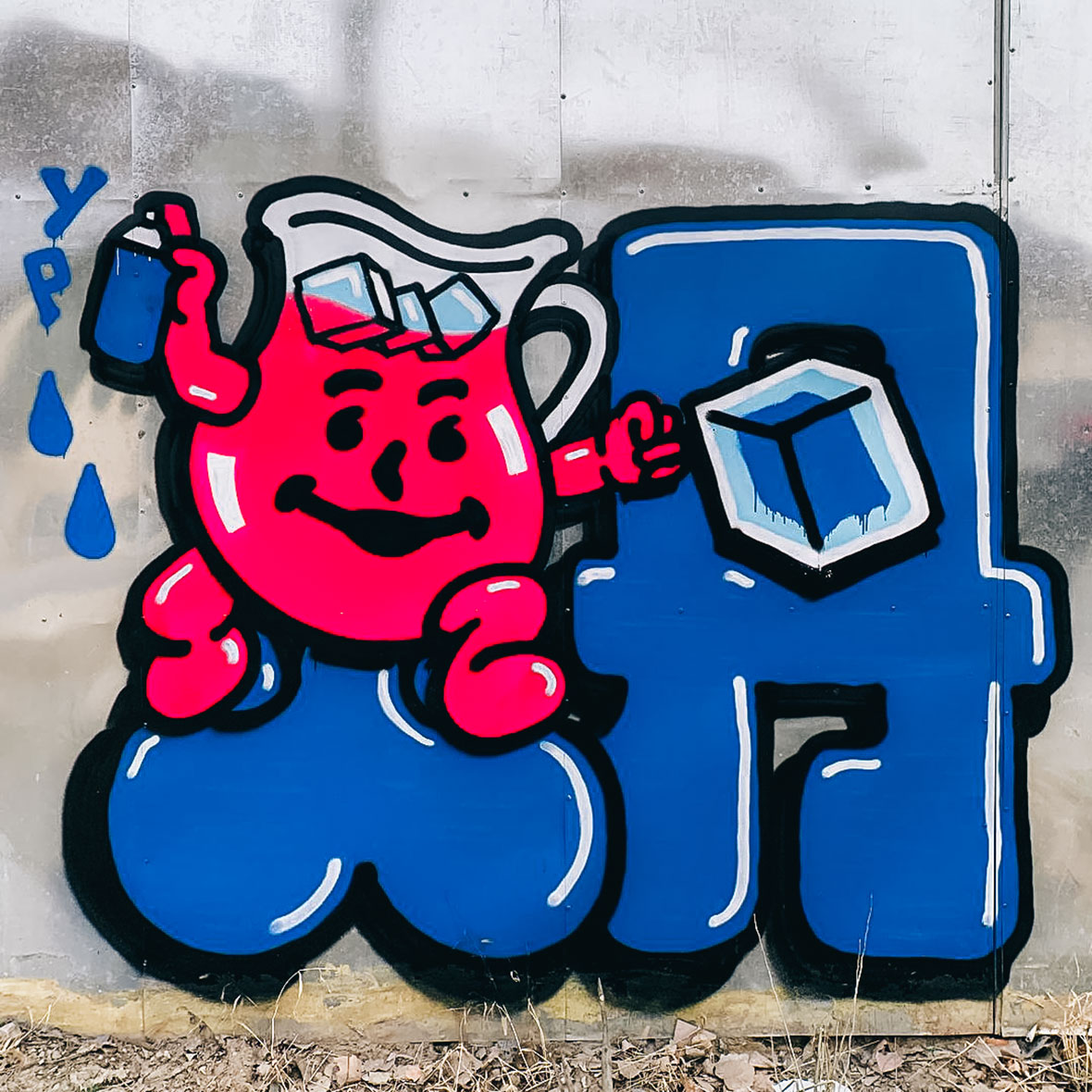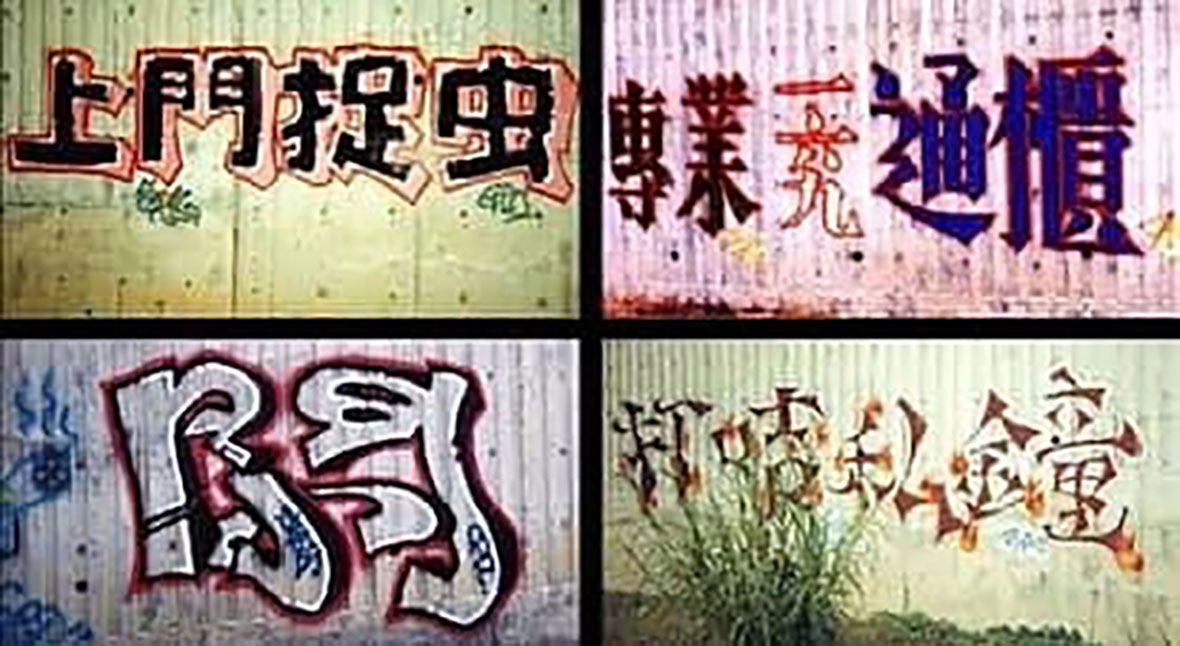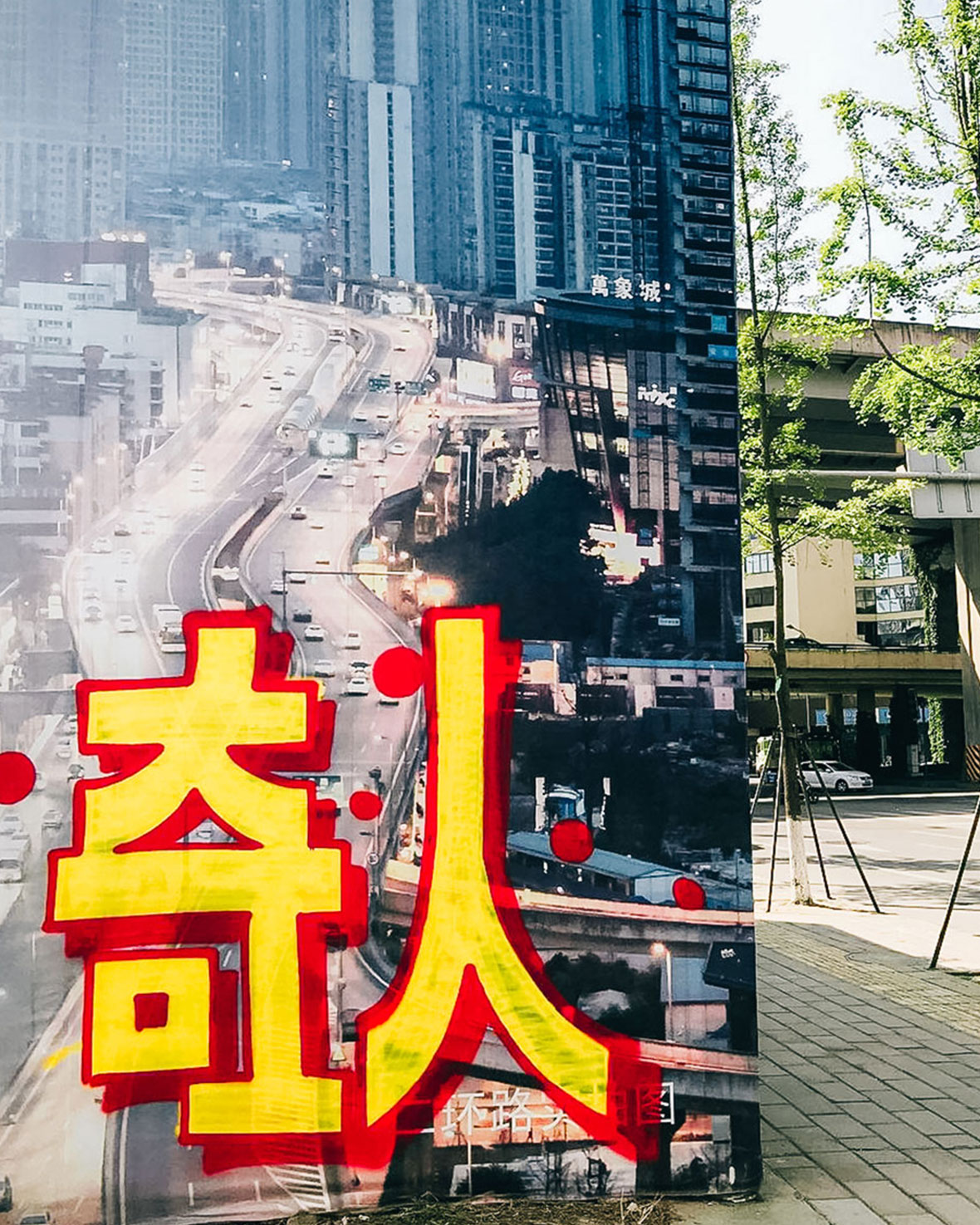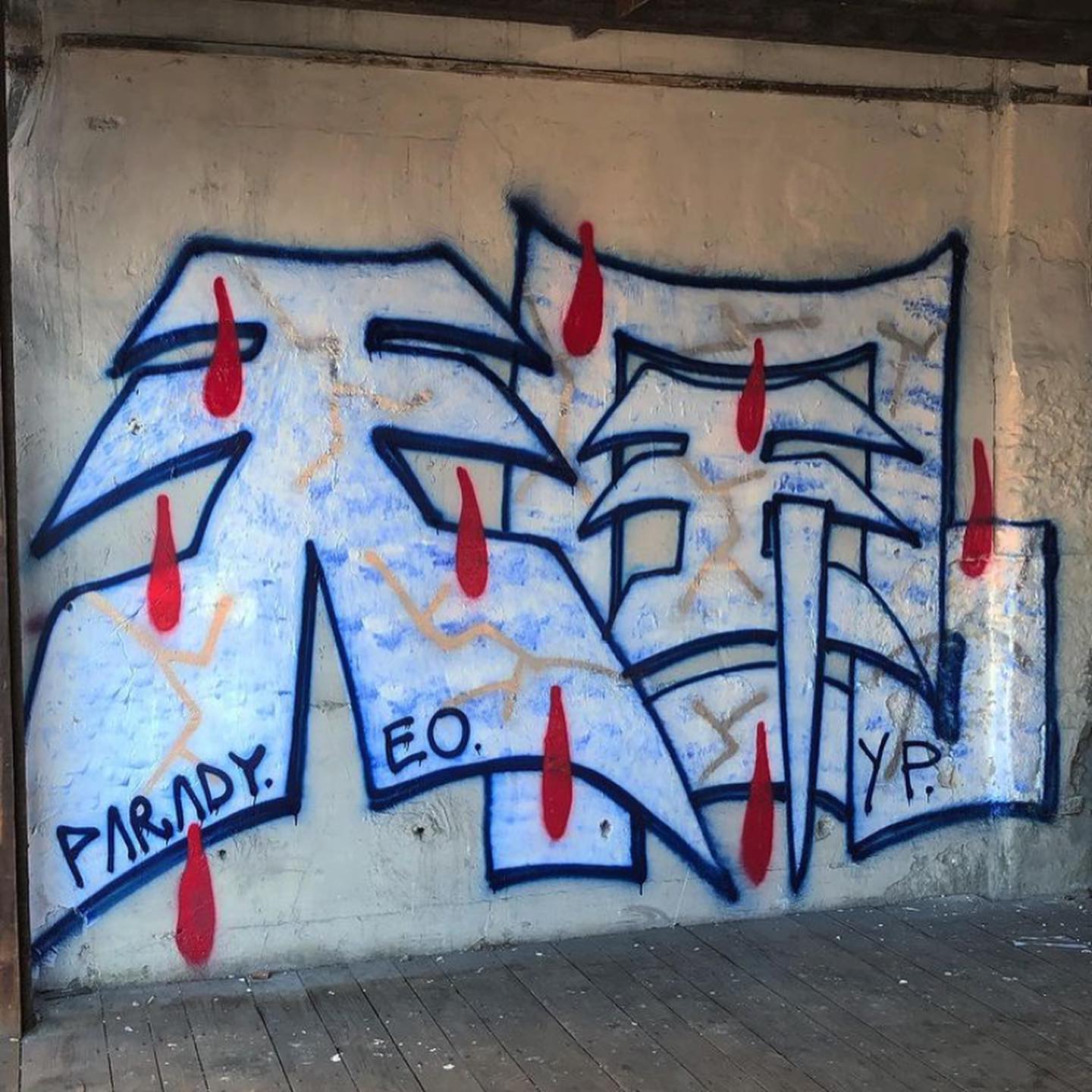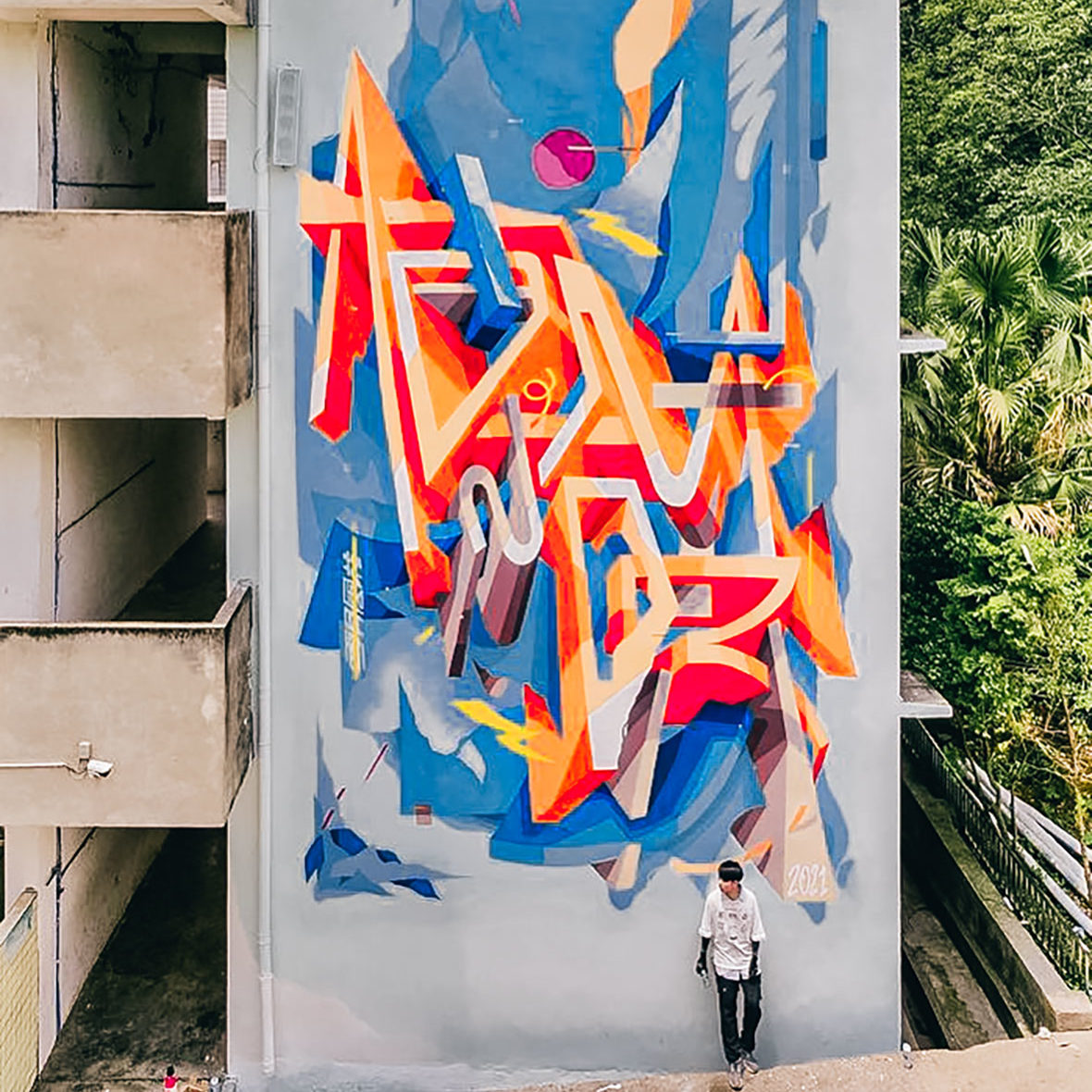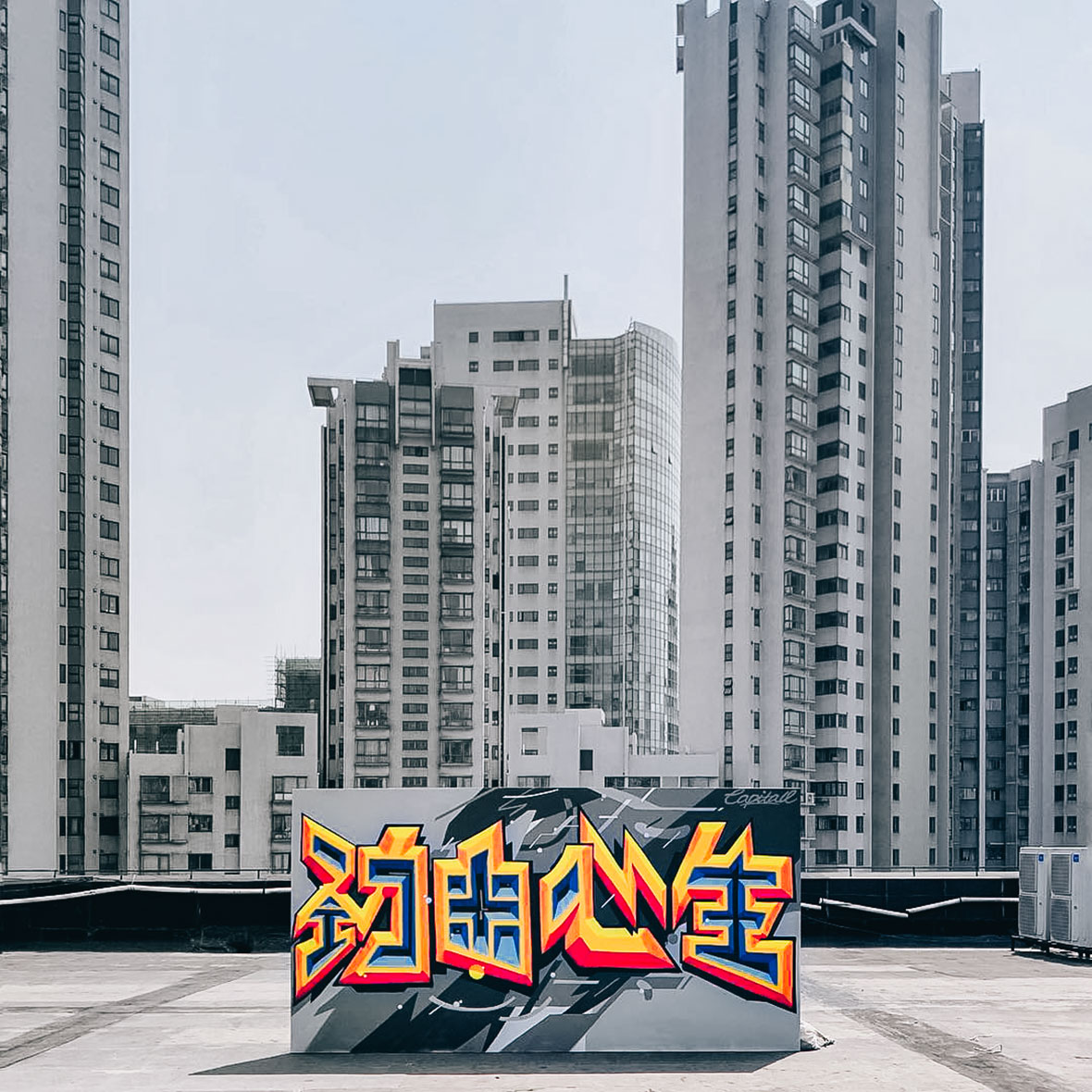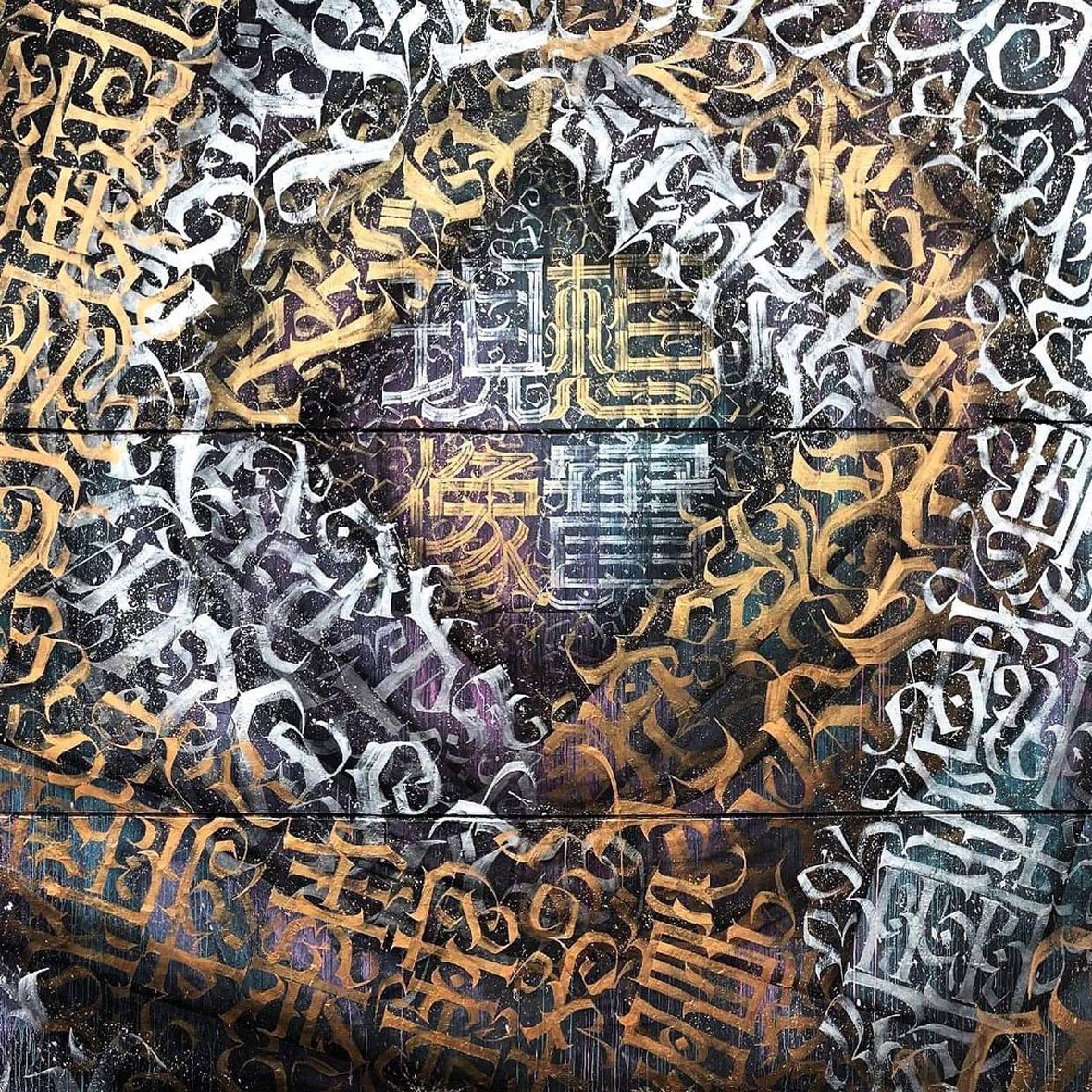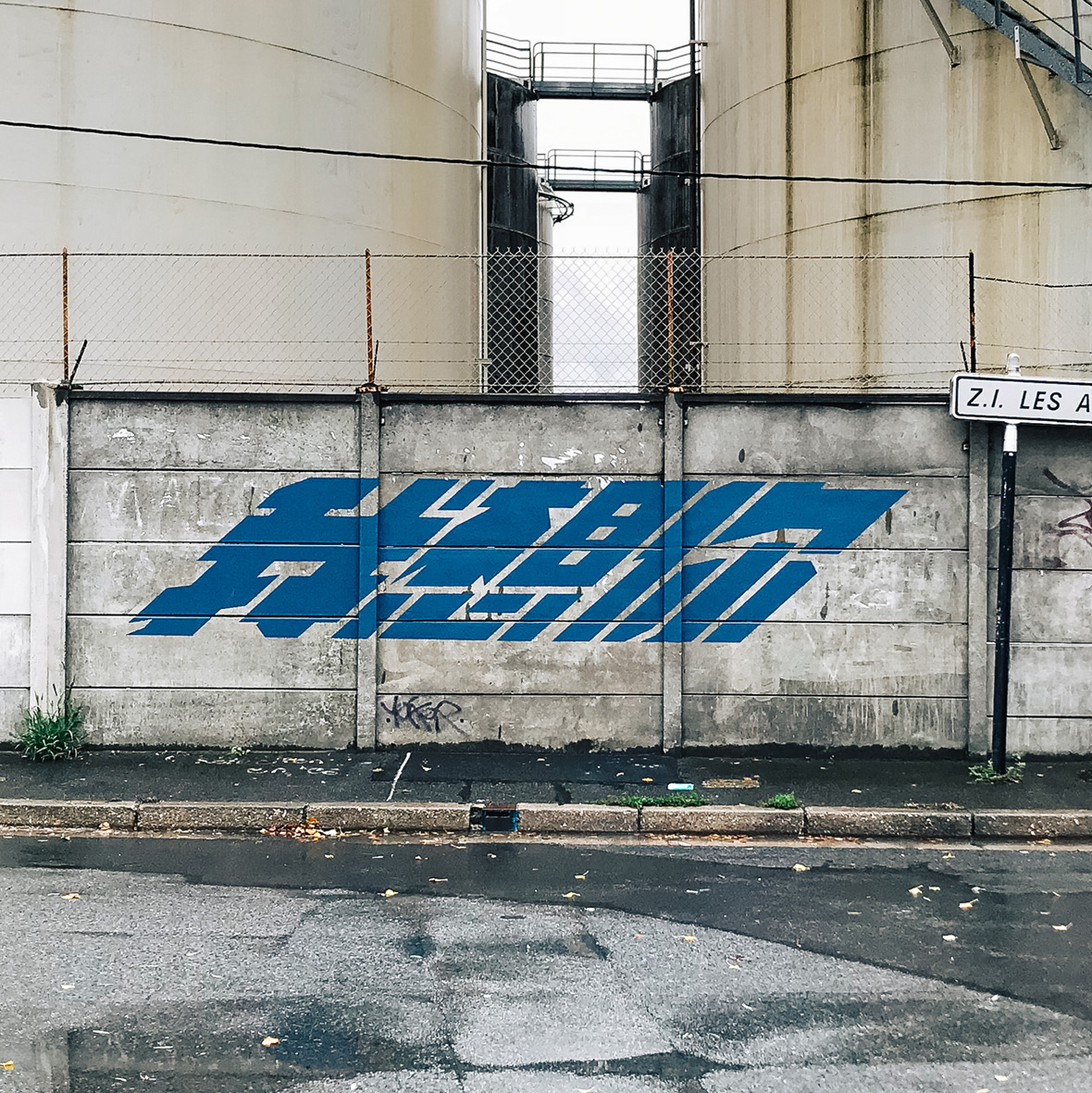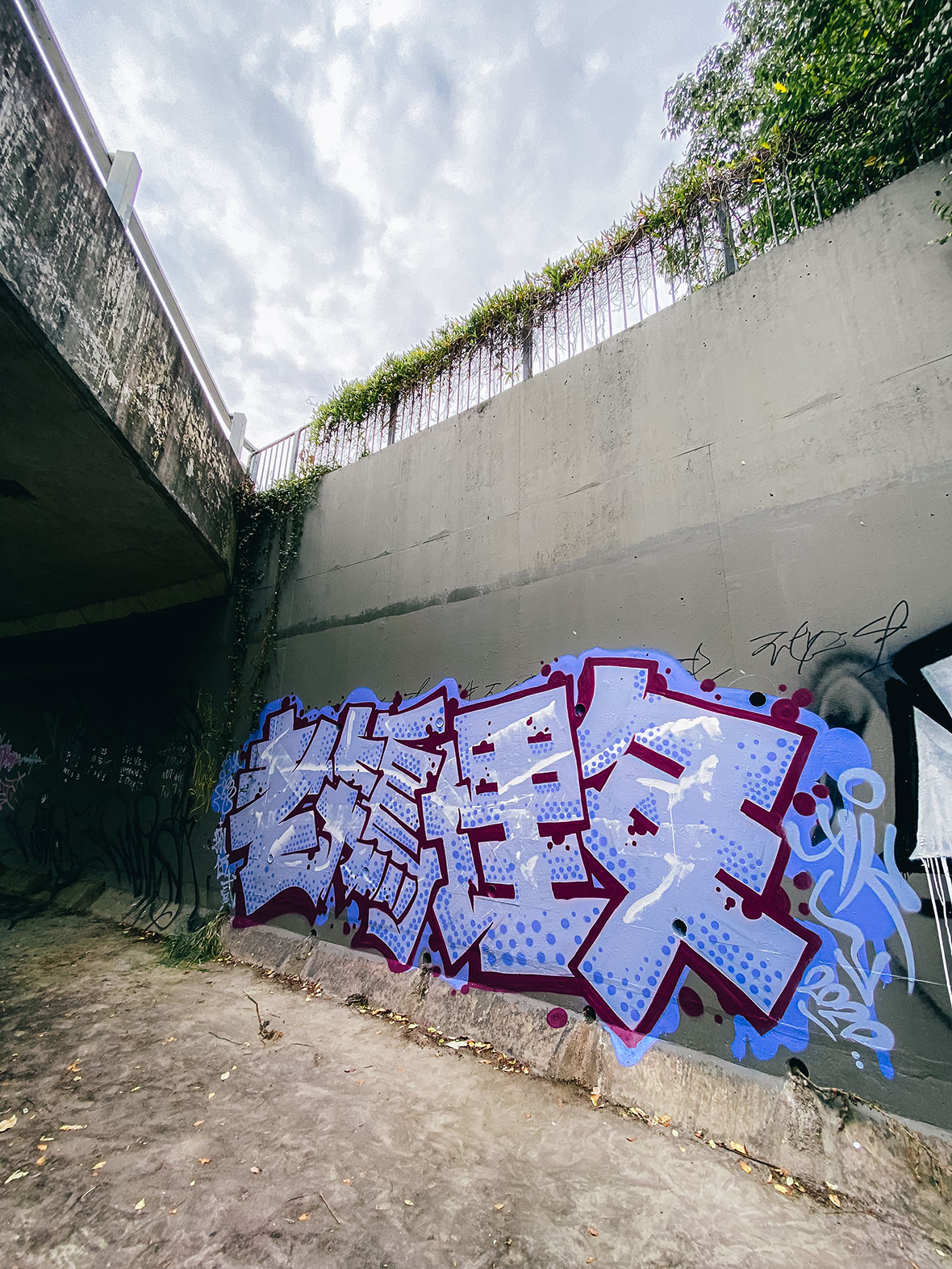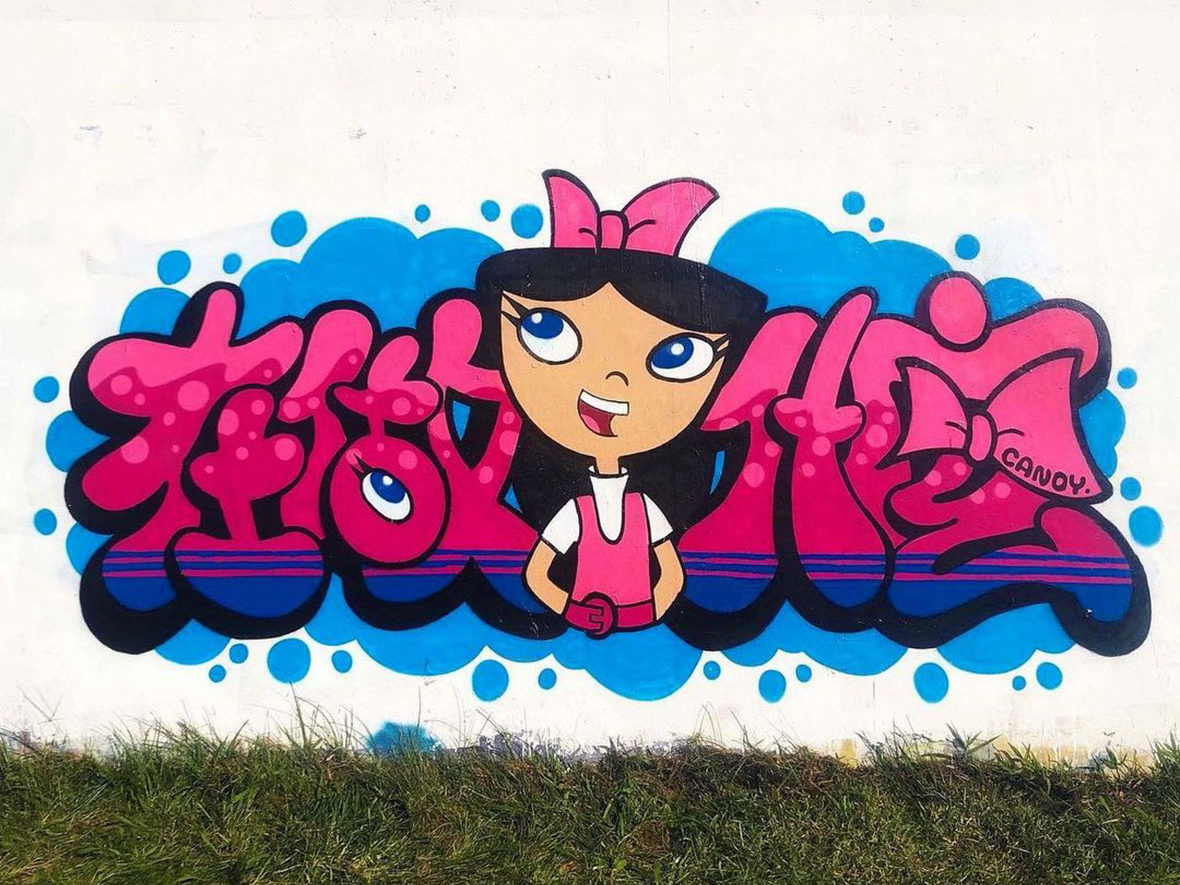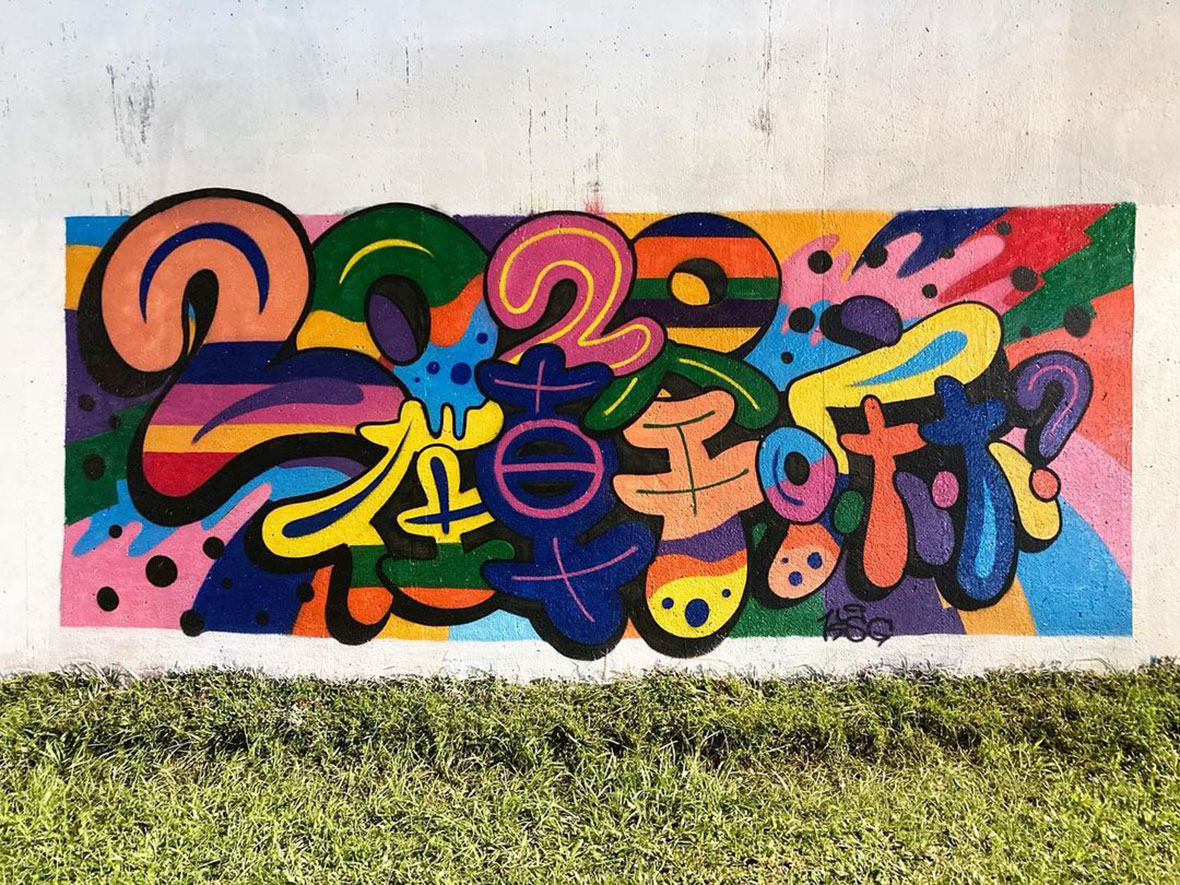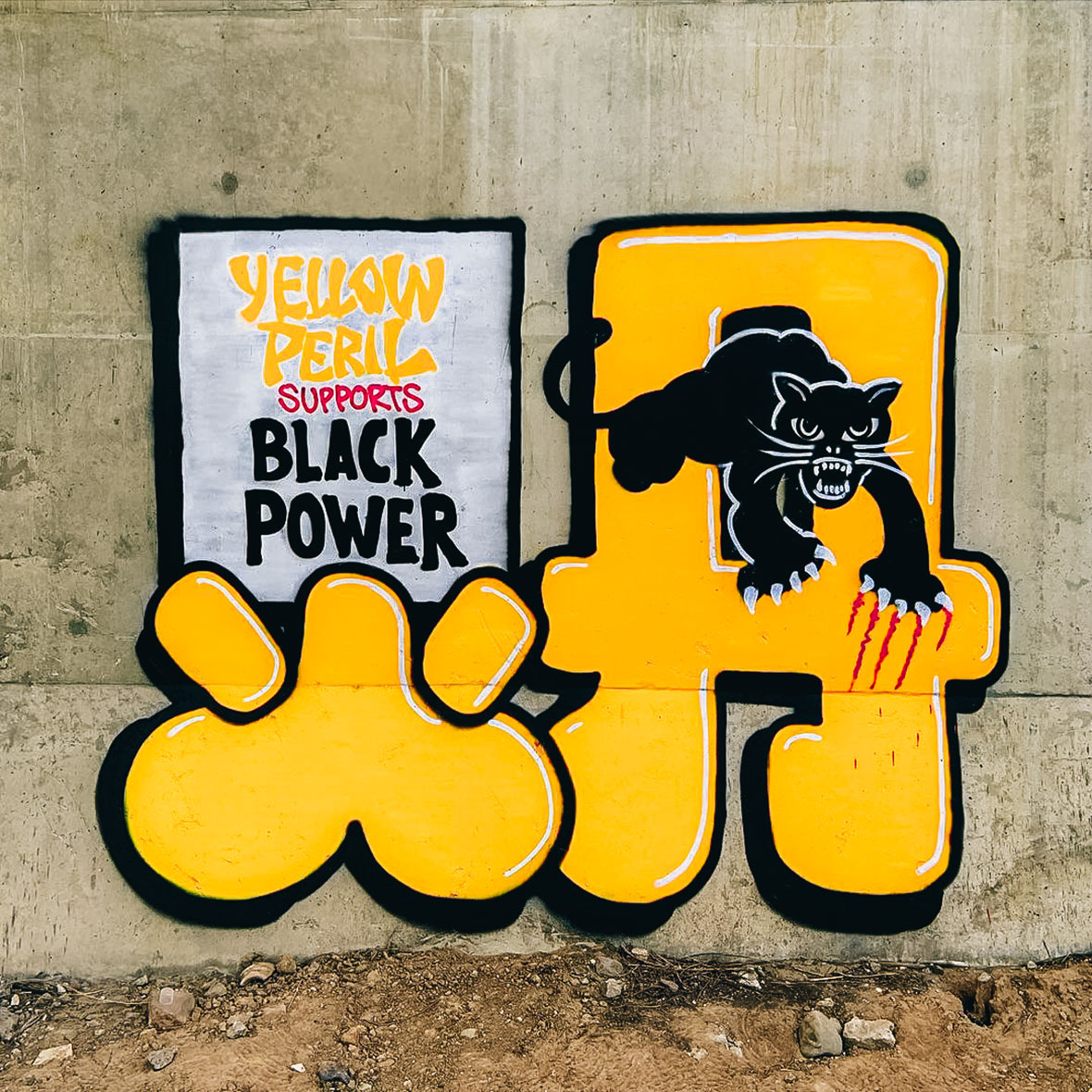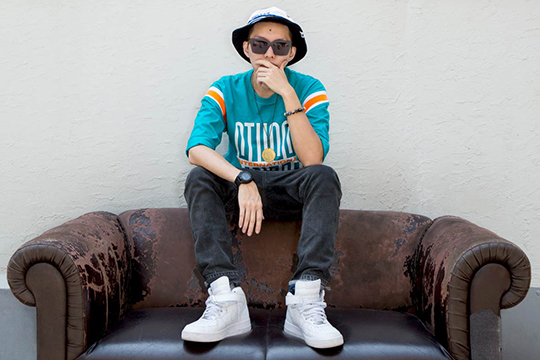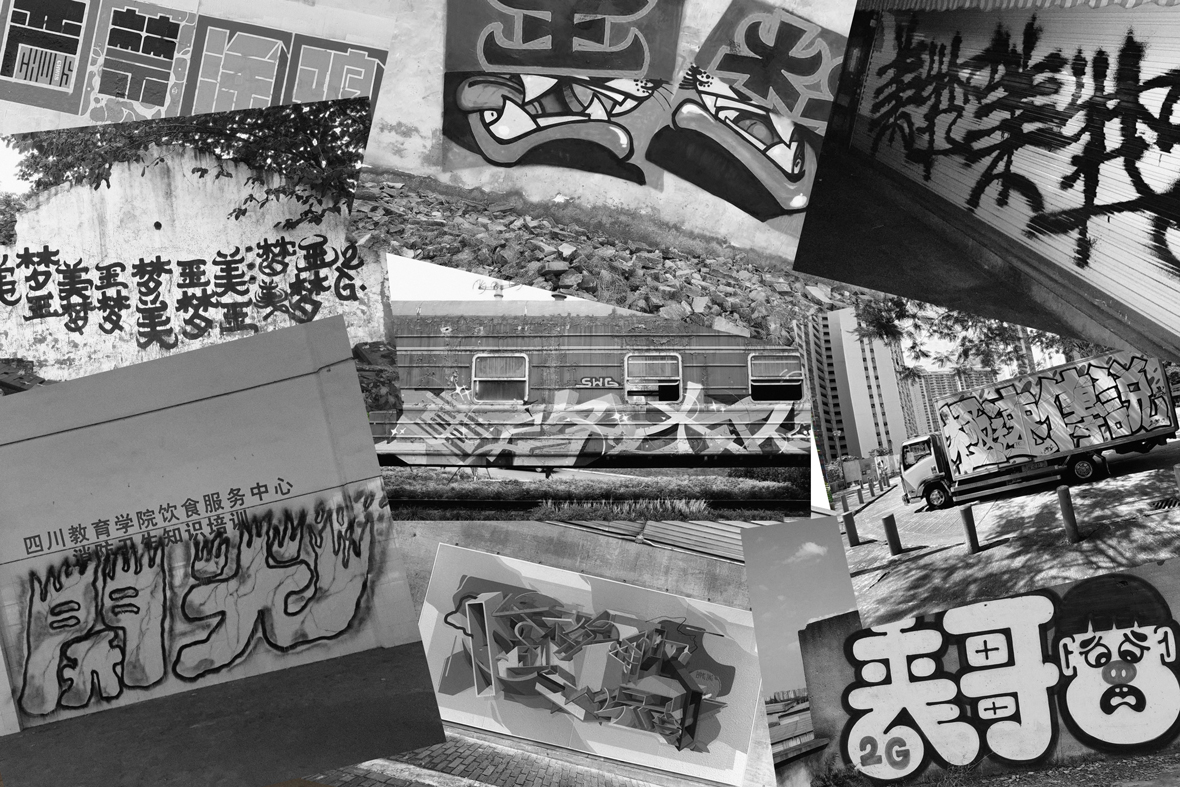
Chinese culture has considered the written letter fundamental to the arts since ancient times. There are billions of people across the world able to read Chinese characters. Manga and anime have brought kanji lettering to a global audience for 40 years. Graffiti has had a foothold in Asia for over 20 years. So where is all the Chinese-language graffiti? It’s still a frustratingly rare occurrence despite all these facts. But there is a new crop of artists taking advantage of missed opportunities and exploring the wealth of creative options from these overlaps. From mainland China, Hong Kong, and Taiwan, to Thailand, Europe, and Chile, these artists have a diverse range of backgrounds, outlooks, and styles.
自古以来,文字书写就被认为是中国文化的基础。全世界能读懂汉字的人有数十亿。在与中国隔海相望的日本,四十年来动漫和漫画持续将日本汉字文化推广在世人面前(日本汉字是由中国汉字衍生出的日语书写语言)。截至目前,涂鸦艺术已进入亚洲二十余载,而中文涂鸦形式仍属罕见。不过现在,有一批新锐艺术家,他们正在尝试从汉字和涂鸦的碰撞中探索丰富的创作灵感。这些艺术家来自中国大陆、香港、台湾、泰国、欧洲甚至秘鲁,他们有着不同的文化背景,以及不同的视角和风格。
Two of the major crews with writers using Chinese graffiti are Yellow Peril and SinoGhetto. Yellow Peril was started in China with the goal of pushing graffiti written in different Asian languages and includes members from across the world. SinoGhetto was founded by a European writer, and welcomes members from all over the spectrum, as long as they have love for Chinese and hip hop culture. In Hong Kong, writers like Boms and Sicko are dedicated to bombing in Chinese, and in Taiwan artists such as Chwis and Candy Lien focus more on blending street art with Chinese type design. Writers like Guangzhou’s Chan13 paint huge graffiti murals and push internationally recognized crews like BAMC and ZNC. In Japan, Serik and Veryone work in kanji, which are Chinese characters that have made it into the Japanese written language. Even European graffiti artists with no connection to Asia, such as Debz and Marx, also create interesting work with kanji lettering. Nobody knows exactly how many writers there are, but it’s likely less than 100 all together worldwide.
全球范围内,汉字涂鸦团队主要由两大分支构成,一支叫“黄祸”(Yellow Peril),另一支叫“汉部落”(SinoGhetto)。“黄祸”起源于中国,初衷是推广那些不同亚洲语言创作的涂鸦作品,在世界各地招贤纳士。汉部落则由一位欧洲艺术家创立,阵容也可谓五湖四海,只要是热爱中文和嘻哈文化的艺术家都能加入。在香港,“爆” Boms 和 Sicko 致力于游击式汉字涂鸦;台湾的 Chwis 和连翊庭(Candy Lien)则把创作重心放在街头艺术与汉字字体设计的融合;在中国南部,广州的陈拾叁(Chan13)擅长涂鸦壁画,同时也致力于推广 BAMC 和 ZNC 这样国际知名的团队;日本艺术家 Serik 和 Veryone 擅长用日本汉字创作;在欧洲,也不乏有像 Debz 和 Marx 这样的汉字涂鸦艺术家,虽置身亚洲之外,但仍坚持用汉字创作。尽管没人曾统计过确切数字,不过大致来看,全球汉字涂鸦艺术家一共加起来也不到 100 人。
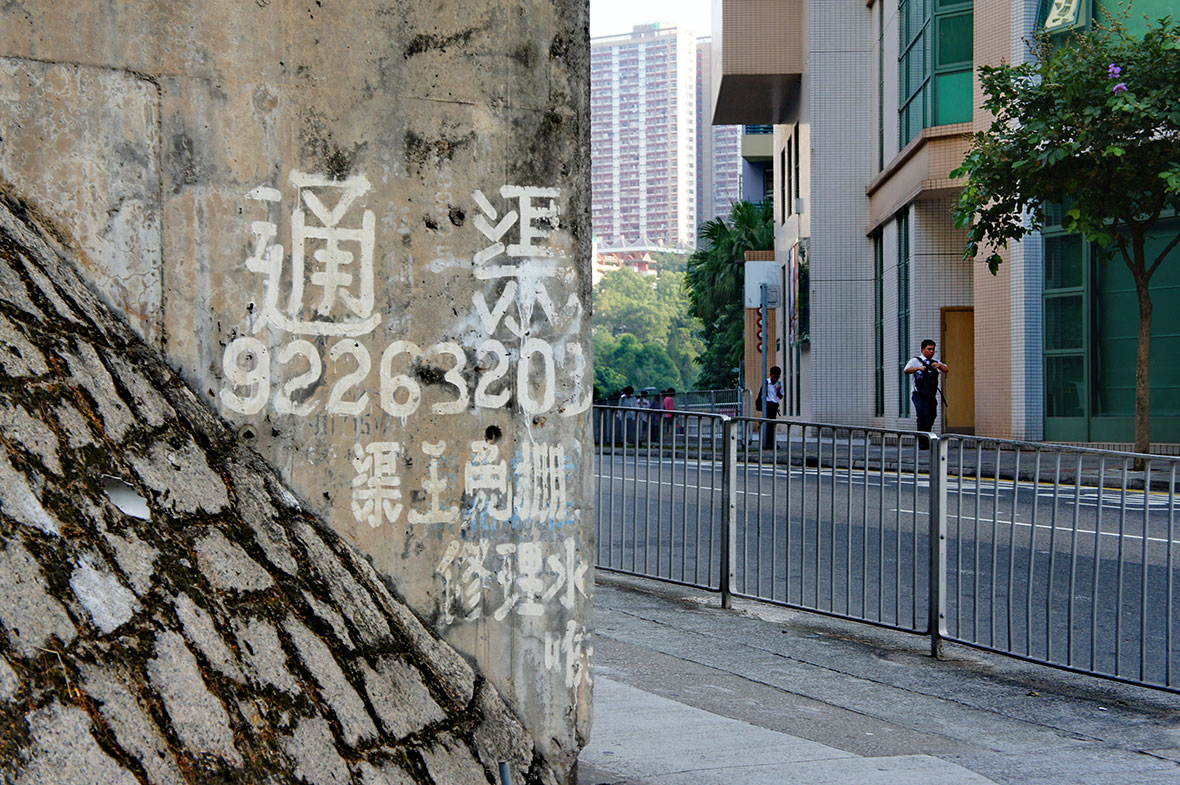
Some of the earliest graffiti written in Chinese comes from Hong Kong, and MC Yan might be one of the first writers to be inspired by hip-hop graffiti culture. After a trip to France in 1997 exposed him to graffiti, he brought it home with him and helped spark a movement. “I have been doing tags over the last 20 years and using Chinese characters has always been my style,” he noted in a past interview. “My three references are from traditional Chinese calligraphy, which is a beautiful art form on its own, adding on modernized typography – and my own creation which is about using Chinese characters inversely.” But there were local writers from entirely different traditions who he says paved the way for him—namely the late “King Of Kowloon” Tsang Tsou-choi, who wrote poetry in the street, and the “Plumber King” Yim Chiu-tong, who advertised his plumbing services on every square inch of the city.
In mainland China, earlier forms of Chinese-language “graffiti” were similarly cheap, guerrilla advertising, which promoted shady services with phone numbers stenciled on walls. “It’s all over here,” says Exas, a cofounder of Yellow Peril and graffiti artist who was born and raised in Beijing. “That type of graffiti is the most famous type of graffiti advertisement. It’s so profitable that there’s a lot of people in every city doing the same thing.” He adds that a lot of graffiti writers and designers now look to this work for inspiration, although none of the advertisers themselves have received recognition, except maybe in the form of patronage of their services.
汉字涂鸦作品最早来自一批香港艺术家,其中 MC Yan 是当地第一批受嘻哈涂鸦文化影响的艺术家之一。1997 年的一次法国旅行,让 MC Yan 第一次接触到涂鸦,他随后把这种艺术形式带回了家,并发起了一场涂鸦运动。他曾在一次采访中谈到:“20 年来,我一直在创作签名式涂鸦,但与西方涂鸦不同的是,我坚持使用汉字,这就是我自己的风格。我有三个灵感来源,一是传统中国书法——它本身就是一种美丽的艺术形式;二是当代字体设计;第三是我自己的原创,但同样基于传统汉字。”还有一些来自完全不同背景的本地街头涂鸦者也同样给予了 MC Yan 极大启发——比如在街头写诗的已故“九龙皇帝”曾灶财(Tsang Tsou-choi),还有在城市每个角落留下管道维修广告的“渠王”严兆棠(Yim Chiu-tong),MC Yan 说:“他们为我铺好了创作之路。”
中国大陆早期的中文“涂鸦”作品和“渠王”的广告很相似——是一种廉价的游击式涂鸦,诸如办证之类的“路边野鸡式”宣传广告。“这里到处都是这些涂鸦,”来自北京的“黄祸”联合创始人灵丹(Exas)说道。“说白了就是广告,利润极为丰厚,每个城市都有很多人在做。”灵丹还提到,这类涂鸦影响过很多艺术家,可惜,原作者们早已不知了去向,那些人甚至从未了解过涂鸦,以及他们的作品如何对涂鸦艺术家带去的影响。
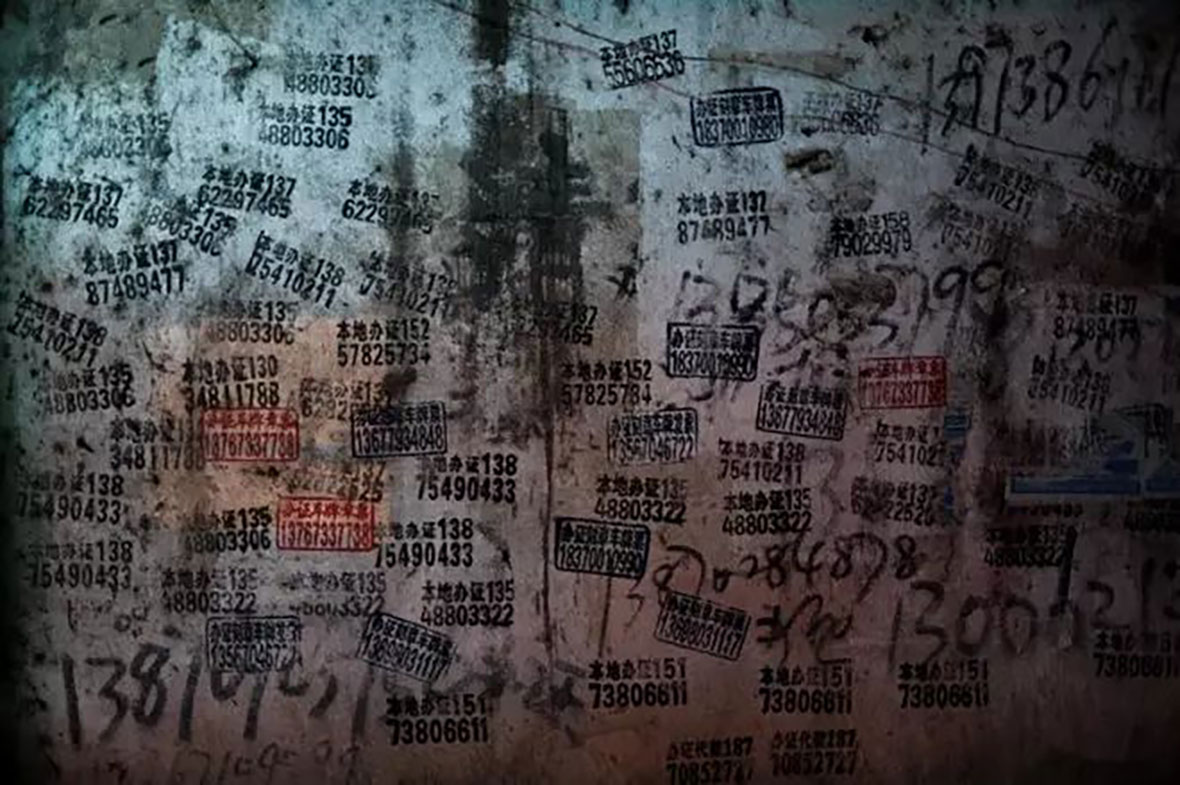
Another popular form of Chinese graffiti outside the New York realm of influence are the candid confessions of everyday people leaving anonymous messages across the mainland, as documented by the Chinese Graffiti Hub blog. “In this era of instant gratification, people may be in need of more forthright ways of communicating,” reasons Lil Quacky, who runs the blog, of the style’s popularity. “This infotech age makes the simple prose of these graffiti shorthands that much more valuable.”
另一种中文涂鸦形式则更像是某种匿名留言,内容多是些赤裸裸的告白、或是内心的独白,以潦草的形式出现在墙壁或废墟。这些涂鸦被“中文塗鴉中心”记录下来。账号的运营者 Lil Quacky 表示,“在这个充满即时满足的时代,人们可能需要更直截了当的沟通方式,留言涂鸦这种形式因此而流行起来。” Lil Quacky 还说,“当下这个信息时代,发自内心的文字涂鸦变得格外珍贵。”
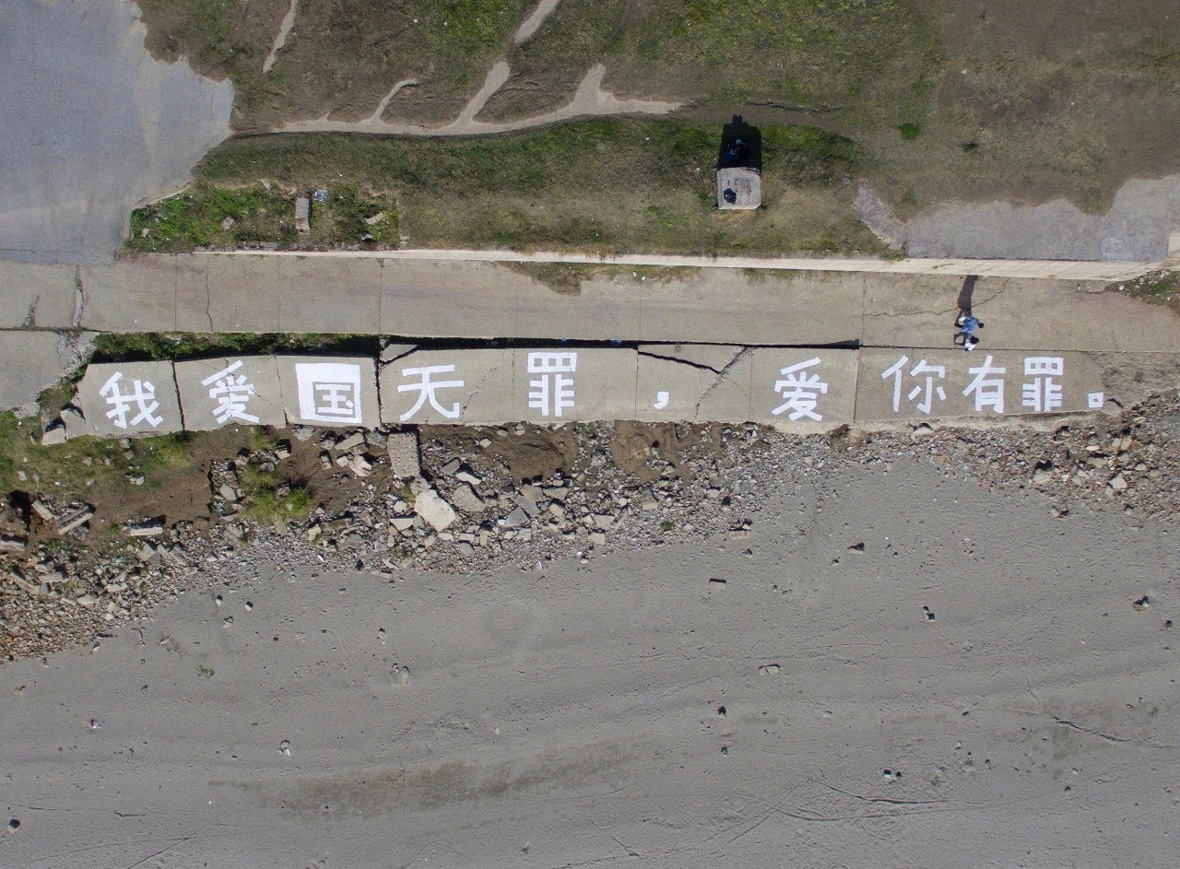
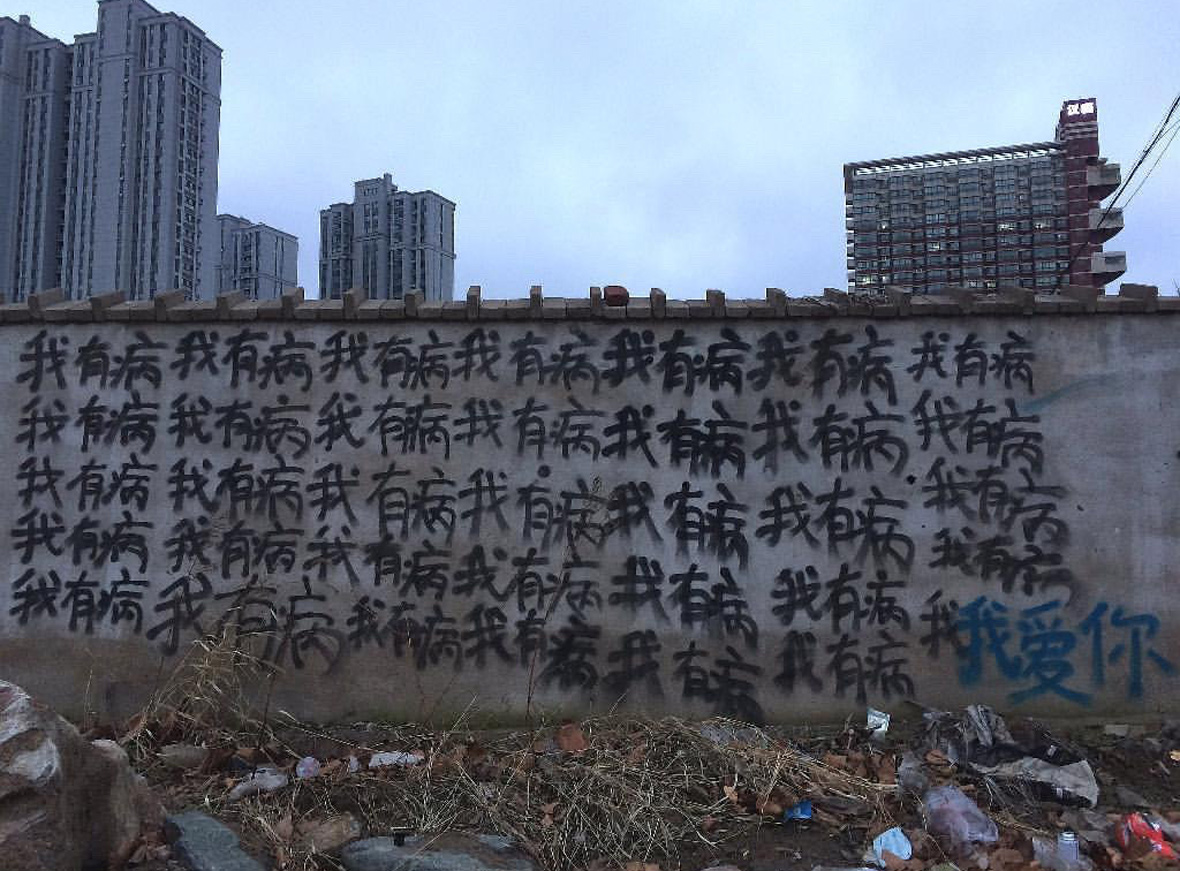
Reset is one of the most active writers in Chengdu writing in Chinese. He started getting up in 2015 but didn’t start using Chinese until 2017. He says one of his big inspirations is Gas, an influential Chengdu writer who started using Chinese characters in the mid-2000s. There are many new writers in the city these days, and Reset has noticed a lot of them are using Chinese. “Chengdu is a city that’s inclusive of different cultures, I suppose that’s a perk,” he says. “The more people getting involved, the more possibilities there are. It’s fun to see and come up with new ideas.” Reset switches his style up between a few different forms. When he takes his time, his pieces are often jumbles of blocky shapes with sharply divided colors. For his more simple pieces, he switches between wormy, curved characters, and straightforward, advertorial ones.
奇人(Reset)是成都最活跃的汉字涂鸦艺术家之一。他从 2015 年开始签名式涂鸦,但直到 2017 年才开始用汉字创作。他称自己的创作深受一位名叫“气”(Gas)的艺术家影响。“气”同样来自成都,在当地涂鸦圈子很有影响力,他最早在 2000 年代中期便开始使用汉字进行创作。奇人注意到,成都这些年涌现出许多新兴的涂鸦艺术家,其中很多人都尝试使用汉字。“成都是一座包容性很强的城市,不同文化能在这里共存”,奇人说,“我想这对汉字涂鸦创作来讲是一个优势,因为参与的人越多,创意的可能性就越大。”奇人能在几种不同风格之间来回切换,他善于堆砌色彩迥异的色块、又能够驾驭朋克式野蛮粗旷的字体。
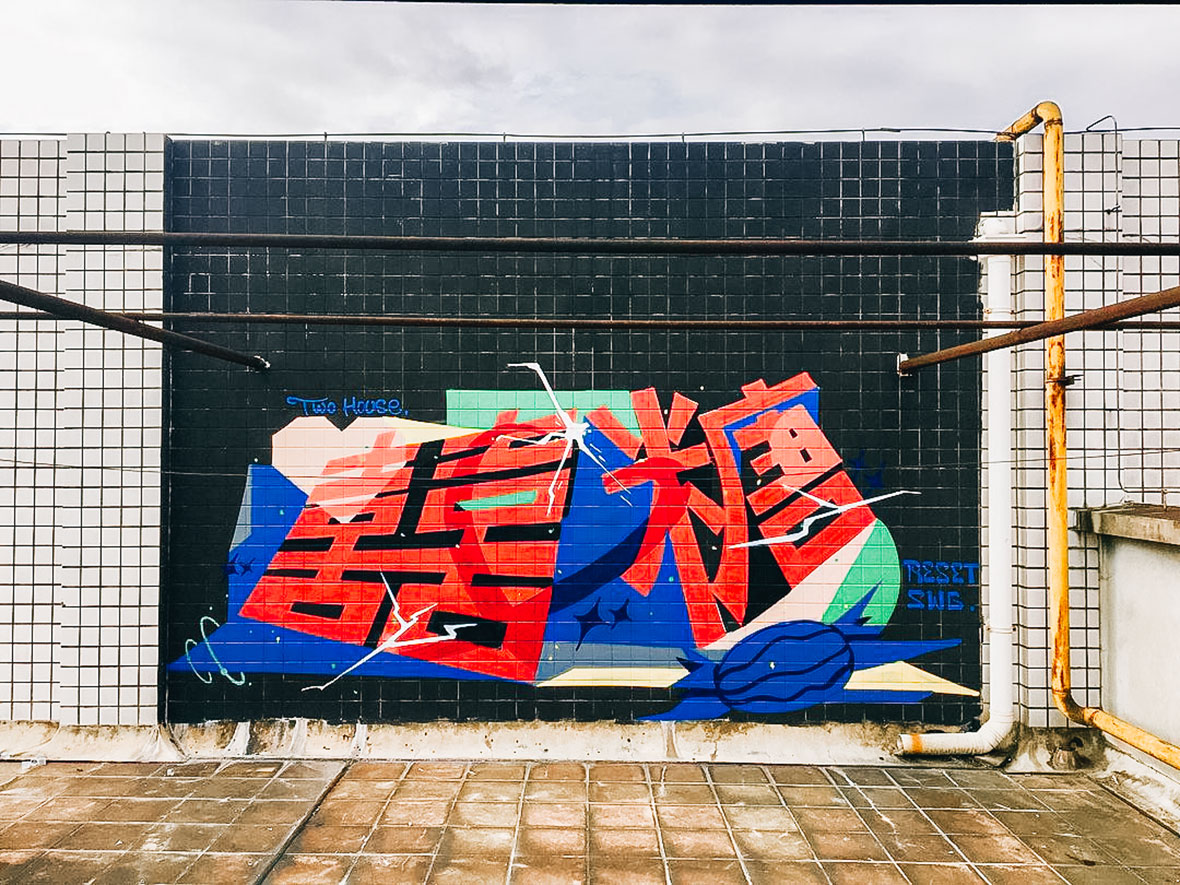
Many of the writers using Chinese characters are fond of “antistyle,” although most wouldn’t categorize themselves as such. Antistyle is a loose, catch-all term for a recent form of graffiti that purposely dispenses with traditional values of can control, color schemes, and details. “The reason why we don’t paint clean colorful walls is simple, we like to paint actively, sometimes more than ten pieces a week and try to create something new every day,” an anonymous member of SinoGhetto explains. “Painting fast pieces with roller paint for example is much more efficient and affordable. But we paint whatever we feel like, we don’t limit ourselves.” The crew is a mix of different ethnicities. Sangge is Chinese, Psiborg is American, Prisoner is Russian, Meimeng is Thai, and Poetry6+ is Czech. Yellow Peril also has a couple non-Asian members, some of whom overlap with SinoGhetto. There’s a lot of overlap between them in general.
“I get bored with legal stuff, graffiti has always been illegal. I just want to go bombing,” adds Paradise, a Chilean member of Yellow Peril who’s now living in France. Her interest in kanji characters came from manga comics. “I had a completely otaku childhood; mangas were my reason to live! They’re the reason I started drawing and loving Asiatic culture so much, so I’ve always loved kanjis. I don’t have the pleasure of knowing how kanjis work and I feel almost guilty because I’m not Asian, but I love the culture so much and I really look forward to learning more.”
尽管大多数汉字涂鸦艺术家都不想把自己归类为“反叛式风格”(Antistyle),但他们当中很多人都青睐这种创作方式。“反叛式风格” 是相对宽泛、笼统的术语,它指向一种区别于现有风格的涂鸦形式——其有意抛弃传统涂鸦中对颜料、配色和细节的控制,转而表现出一种原始、野生的呈现方式。“我们不喜欢那种精致的、色彩丰富的墙画,反而喜欢那种更加随性、自由的创作状态,我们有时一周要画10多面墙,每天都有新的想法诞生”,“汉部落”的一位匿名成员这样解释,“比如用滚刷来快速创作,那样的确更高效,也更经济。但我们倾向于画任何我们想画的东西,而不希望被创作原材料限制。”“汉部落”的成员来自不同民族,Sangge 是中国人,Psiborg 是美国人,Prisoner 是俄罗斯人,Meimeng 来自泰国,poey6+ 是捷克人。“黄祸”团队成员也来自不同国家,其中一些成员也同时是“汉部落”的一份子。团队之间有很多来往。
“我厌倦了合法涂鸦。涂鸦从来都是一项非法活动,我更倾向于‘打游击’。” 艺术家天国(Heaven )说道。天国是“黄祸”团队的一员,来自秘鲁,现居住于法国。她最早对日本汉字的兴趣源于日本漫画:“小时候完全是个御宅族,漫画是我对生活的动力!它促使我开始画画,也让我深深爱上亚洲文化。我一直都很喜欢日本汉字,然而,我没有特别多兴趣去探究日本汉字的语义。我虽然不是亚洲人,但亚洲文化让我着迷、让我想要深入探索,一直没有机会好好去学习,实在有点可惜。”
Chan13, a writer from Guangzhou, is quite the opposite. Although he’s fond of catching tags and throwies, he only promotes his large production work, which is impressive in detail and scale. As an architecture student, he views his graffiti in terms of design and mapping, resulting in letters plotted like buildings on a street grid. “Chinese characters are quarter-bounded and each character has its own discipline within these boundaries; its own outlook, shape, and structure,” he explains. “I try to reflect the city I’m painting from a bird’s view. The demands of the modern city are the same in the West and East but there are also differences, so I try to illustrate this through small adaptations in the font I’m creating or color schemes.”
来自广州的艺术家陈拾叁(Chan13)则与天国不同。他有自己的大型涂鸦作品,同时也专注于签名涂鸦和泡泡字。作为一名建筑专业学生,陈拾叁常以设计和绘图的角度来构想自己的涂鸦。在他眼中,汉字笔画的排布,就像是地图上被街道划分的建筑物。陈拾叁解释说:“汉字的笔画分布在方格内,每个汉字在方格里都有自己的规则,有自己的外观、形状和结构。”他进一步阐释自己的城市主题作品:“东西方建筑具有差异性,鸟瞰之下不尽相同,我希望从这个角度入手,来探索汉字在不同语境下的多样性。”
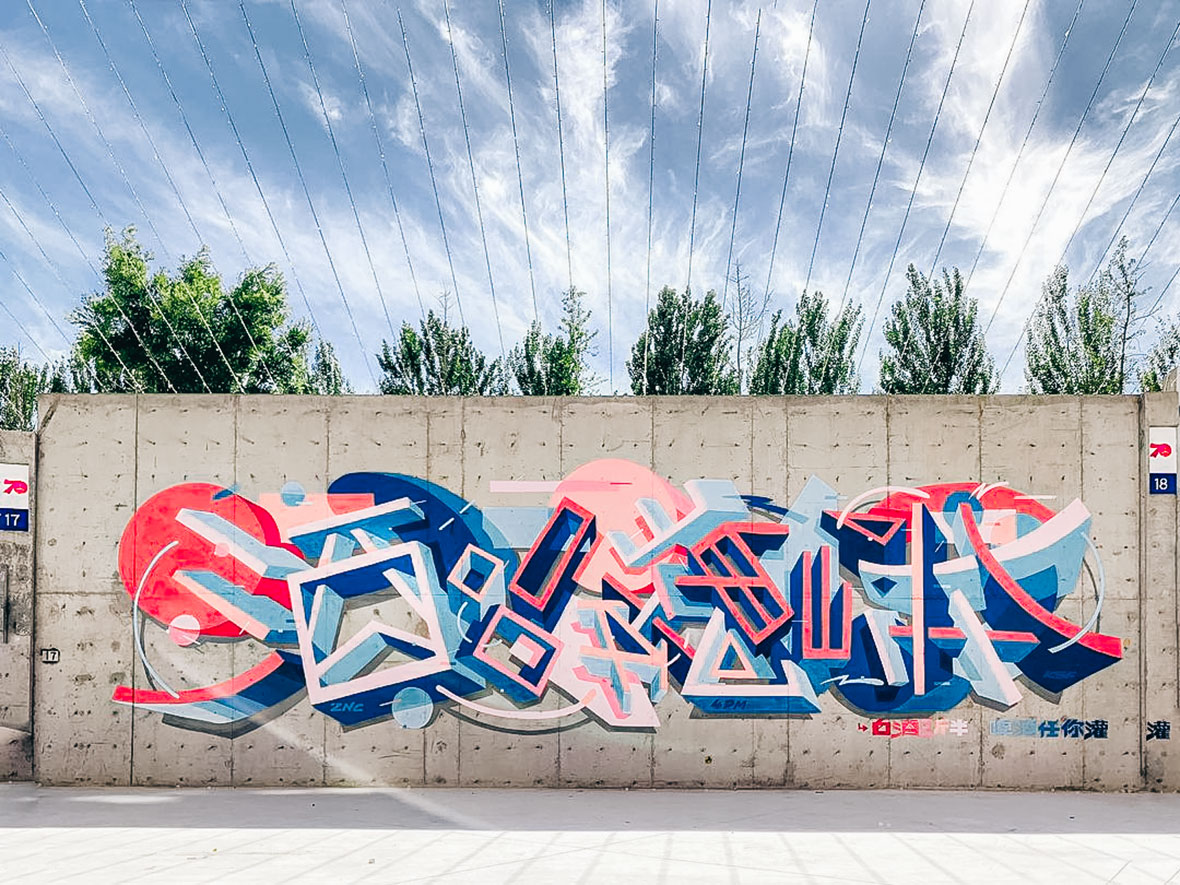
Growing up, Chan13 was first exposed to graffiti on his walks to and from school: “We had some of the earliest practitioners of graffiti in China, starting in the ’90s. I don’t know who they were but we can still see their works.” They wrote words like “soul” and “hip hop,” using brushes for tags, throw ups, and type-oriented murals. “In 2008 I got really into vandalism,” he laughs. “I got caught carrying spray paint to school with me. After a while I realized certain places make it easy to get caught, so I focused on spots that won’t make anybody unhappy.” He says plenty of writers still bomb there today.
“In 2013 I started to wonder why I was writing in English when I’m Chinese,” he recalls. “It would be constructive to use something from my own culture. Graffiti is supposed to be non-elitist and decentralized. If there was a fixed form for what it was supposed to be it wouldn’t be true to its roots. I also enjoy it more and I’m familiar with it. It’s generous to share it with others and I wanted to gain an audience. I wanted people to understand what I was doing, to consider it art.” He says he was inspired to switch by his crewmate Touch as well as Gas from Chengdu.
But switching to such a different form of written language was like starting from scratch. “By deconstructing the existing view of graffiti, I needed to reconstruct a new discipline for myself,” Chan13 says. “I had to destroy all my previous efforts in English language graffiti. It’s a little bit risky to start over, and it took me about three years to find my new style.”
少时的陈拾叁在他上学的路上第一次接触到了涂鸦:“中国最早的涂鸦是在 90 年代。我不清楚当时是谁在做,但现在仍然可以看到他们的作品。”早期实践者写下“灵魂”和“嘻哈”这样的词,他们用笔刷创作签名、泡泡字,这些作品往往由字体主导。陈拾叁笑着说:“2008 年那会儿,我便开始在公共区域涂鸦,甚至有被抓到过。后来,我发掘城市中一些醒目但不会惹麻烦的地方,如今依然有许多艺术家在那里涂鸦。”
涂鸦之后的几年,陈十叁开始思考:为什么我是中国人,却要用英文涂鸦?他说:“我想从自己的文化中去借鉴一些东西。涂鸦本来就应该是非精英主义、去中心化的。如果一定要用一种固定形式来阐释涂鸦是什么,那就背叛了涂鸦的本真。我更熟悉汉字,我也更喜欢用汉字涂鸦。我分享作品,是想要找到受众和认同,我想让他们理解我在做什么,促使大家以一种艺术的眼光来看待涂鸦。”在成都同侪 Touch 和气的影响下,陈拾叁正式转向汉字涂鸦创作。
然而,转变一种语言来进行涂鸦,相当于从零开始。陈拾叁说:“我需要解构原来的创作理念,然后重建一种新的创作语言。这意味着我要放弃之前所有的英文涂鸦手法。重新开始是有点冒险,我大概花了三年时间才找到适合自己的路子。”

Chinese characters can be complicated too and if the wrong line is changed, it can alter its meaning entirely. Artists like Tacos, a French writer who partially grew up in Shanghai, say he paints in a very simple style because of this fact. And Blackzao, a writer in Taiwan who bombs in English, says this is why he only writes in Chinese when doing calligraphy. CreepyMouse is another Taiwanese graffiti writer using Chinese text, but he focuses on calligraffiti, which alters characters in distinctly different ways.
Exas, a writer from Beijing, also found the transition of languages challenging: “Chinese characters take more time to write and it’s hard to develop a cool style because you can’t bite no one.” He started writing graffiti while in high school around 2005 but says he was a “toy” (graffiti slang for a novice) then, only imitating the work of European writers. MC Yan was finding some attention in magazines at the time and was the only writer that Exas had seen using Chinese, but it wasn’t until 2012 that he decided to focus on working in Chinese himself. He was inspired by his crewmate, Funk, and began looking into Chinese characters that resembled his English name, which is how he came up with his Chinese nickname, líng dān (灵丹), which translates into “panacea.” “The first character of Panacea means ‘soul,’ so we appeared on the streets as funk and soul together,” he explains. Exas’s original crew is BJPZ, a group of OG Beijing writers, and he says they all write in Chinese, but that it’s mostly commercial work, more like design than true graffiti.
His lettering in Chinese resembles a traditional simple style, with straight lines and rounded edges. It closely resembles the Chinese Cai Yun font, although that’s unintentional. “I didn’t even realize that! I guess it happened because it’s simple enough to paint and has that fat throw-up look.” It fits his preference for bombing over legal work. “Graffiti has to appear in people’s daily life, in the urban environment, not just in an art district or on shopping mall walls,” he says. “It’s almost over now because of work being buffed overnight. Beijing had a time where people came from all over the world to paint, even the subways got painted. In 2008, the government was promoting graffiti, they saw it as urban decoration. But not anymore.”
Tacos 来自法国,在他的成长过程中,有一部分时光是在上海度过。他说,“汉字的结构复杂,如果笔画出现偏差,整个意思也会随之变化。”出于这个原因,Tacos 在创作时特意规避繁琐的风格,以清晰呈现汉字的完整结构。出于同样的考虑,台湾艺术家雷克布(Blackzao)创作游击式涂鸦时只用英文,而汉字则是以书法的形式出现在创作中。台湾的汉字涂鸦艺术家異鼠(CreepyMouse)则专注于书法涂鸦,以大手笔来改编汉字。
同样,来自北京的艺术家灵丹(Exas)也发现转换创作语言具有很大挑战:“写汉字会花更多时间,而且很难形成一种很酷的风格,前提是你不能去偷任何人的创意和想法。”2005 年左右,正读高中的灵丹开始涂鸦。他说自己初出茅庐的时候,只会模仿一些欧洲艺术家的作品。当时灵丹关注到的唯一一位使用汉字的艺术家是 MC Yan。直到 2012 年,灵丹才下决心专注于汉字涂鸦。受到团队成员 Funk 的启发,灵丹开始寻找和他英文相匹配的汉字,最后他找到“灵丹”二字,意为万灵药。灵丹说,“‘灵’的意思是‘灵魂’,包含‘放克’和‘灵魂’的结合,代表我们在街头的姿态。”灵丹最初的团队叫“BJPZ”,由一群北京土生土长的艺术家组成,他们都用汉字创作,但主要做商业用途,这样的作品更像是设计而不是涂鸦。
灵丹认为,“涂鸦必须出现在街头,它必须出现在人们日常生活中可以看到的地方。它不应该只是画在艺术区或者是购物中心的墙上”。然而现实是,“游击式涂鸦现在濒临消失,很多作品被城管连夜清除。之前有段时间,全世界的涂鸦艺术家都在北京扎堆,甚至连地下铁道都能看到他们的身影。2008 年,政府甚至把涂鸦当作城市装饰去推广,可是现在,一切都变了。”

In Hong Kong, it’s more common for writers to paint sewer tunnels and abandoned buildings or to paint trucks and street gates under the cover of night than it is to paint permission spots. “I’d never reject a legal wall, who’d say ‘no’ to a beautiful, sexy virgin wall right?” Hong Kong-based writer Boms laughs. “But it’s hard to find legal spots here. Also, exploring the city is fascinating, every time it’s a new adventure.”
Boms started writing in 2014 as an extension of his interest in breakdancing. But he was working an exhausting job as a designer in an online marketing agency, often slugging away at 12 hour to 15 hour shifts. In 2017, he finally quit and became an artist full time and this is also when he started to find his footing in graffiti. His tag is in English but his pieces are in Chinese, and his style is loose and cartoony, with letters that seem to bounce around with energy. Sometimes, as a way of blowing off steam, he’ll write curse words and lewd slang instead of his alias.
在夜色的庇护下,下水道、废弃建筑、卡车和大门是香港涂鸦师的领地。“我从不会拒绝任何一堵墙壁,没涂过的地方总是那么性感、且美丽。”香港艺术家爆(Boms)笑着说道,“在一座城市里去寻找适合涂鸦的地方,这个过程本身就很迷人,每次都像是一场新的冒险。”
2014 年,爆延续他对霹雳舞的兴趣,开始了涂鸦创作。当时的他在一家线上营销机构担任设计师,工作很累人,经常一天工作 12 到 15 个小时。三年后,他终于辞职,成为一名全职艺术家。也就是在这个时候,他开始渐渐形成自己涂鸦风格,以汉字作为创作根基。他的风格变化自由,带有鲜艳的卡通色,动感笔触在墙壁上下跳动。而有时为了宣泄心中的情绪,他也会留下些脏话和俚语。
Many writers have found that writing in Chinese characters make their pieces stand out, regardless of where they paint. “When I lived in New York, I wrote in both English and Chinese, but nobody noticed my English pieces,” Exas says. “It was like they just disappeared. But the graffiti photographers spotted my Panacea pieces. When you represent your culture it makes you unique.”
This is true within Chinese speaking countries, too: “Chinese characters speak more to Chinese audiences, since they can read them and concentrate on their meaning,” SinoGhetto explain. “It’s much more fun to communicate with your audience, because people in the city really care about what you are writing. You can make them laugh, feel sad or angry or whatever. We switch between various languages based on where we live. For example if someone from our team moves to Germany or Mexico they will surely come up with something new based on their surroundings and life experience.”
许多涂鸦艺术家发现,无论在哪里创作,用汉字涂鸦往往最能吸睛。“住在纽约的时候,没人会留意我的英文作品,反倒是我的汉字涂鸦比较受关注。”灵丹说道,“当你的作品代表自己的文化时,就会让旁人眼前一亮。”
不光在西方国家,在讲汉语的国家亦是如此。“汉部落”团队认为:“汉字对中国观众来说更有吸引力,因为他们看得懂,就会去了解涂鸦背后的故事。与观众获得交流让涂鸦创作变得更有趣。观众和你的作品一起哭、一起笑、一起伤心、一起愤怒。此外,我们还会根据团队成员的居住地来切换不同的创作语言,会根据身处的环境和生活经历构想出一些新的东西。”
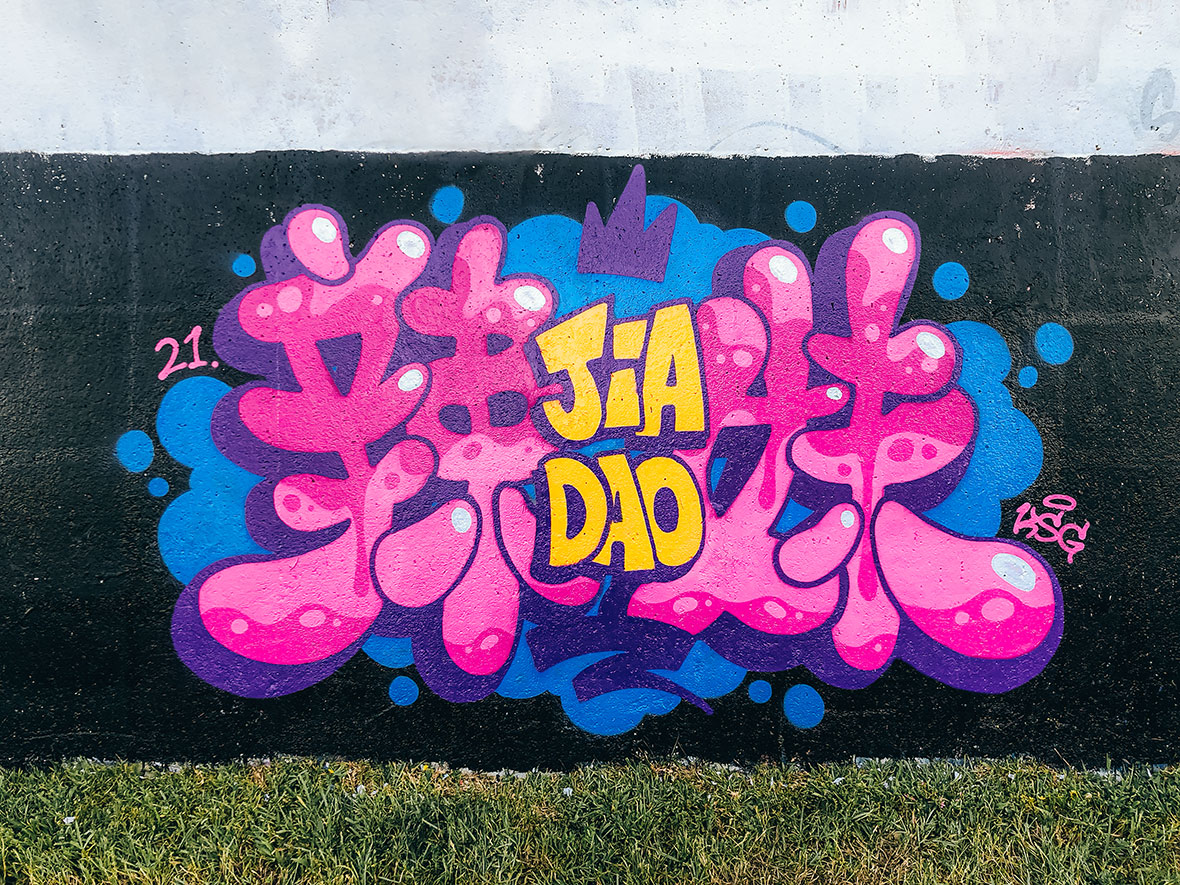
“There’s such a small amount of Chinese graffiti in Taiwan that when you see it, it makes it special,” adds Candy Lien, a street artist from Taipei City. As a designer before she was using spray paint, she also applies her graffiti letters to other forms of art, like nail art and package design. And when she paints walls, she prefers to write phrases rather than her name. “Chinese is my mother language; I speak Chinese every day,” she explains of her decision to incorporate Chinese.
Chan13 also prefers to write phrases like “Better taste than regret” or “To be either intellectual or individual.” He only writes his name in his productions once a year. A recent piece that reads “Serendipity” provided an interesting example of the challenges of translation. “It was painted in Boston, so a lot of people asked me to explain it,” he says. “Sometimes I can’t find equal English phrases to express Chinese idioms. “Serendipity” in Chinese is an idiom referring to one feather of a unicorn. In China they don’t have a horn, but have feathers instead. It represents a certain type of luck, a curious opportunity of finding small, beautiful treasures in life.”
In addition to the practical fact that this is the language he grew up with and studied since he was a child, Chan13 sees a philosophical reason for writing in Chinese as well: “Life is hard, right? When you do graffiti and have to follow rules, it makes life harder. Graffiti is supposed to be non-elitist and decentralized. If there was a fixed form for what it was supposed to be, it wouldn’t be true to its roots.”
现居台北的街头艺术家连翊庭(Candy Lien)表示,“台湾本土的汉字涂鸦依然非常少见,这使得它成为了一种特殊的存在。”连翊庭原先是一名设计师,后来才开始涂鸦。她也把涂鸦同样运用在更多领域,例如美甲艺术和包装设计。与众不同的是,她偏爱短语式涂鸦:“中文是我的母语,我们每天都有在讲。”她的短语往往具有互动性,比如“2020年你在幹嘛?”,“在幹嘛”一语双关,“幹”字也表示“操”。“这就是 2020 年该有的心情哇!”连翊庭笑着说道。
陈拾叁也喜欢写类似的句子,譬如 “试过,总好过后悔” 或者 “要么才智出众,要么不从众” 等类似的句子。他每年只在自己的作品中署名一次。他最近一幅题为“意外机缘(凤毛麟角)(Serendipity)” 的作品,带给翻译巨大的挑战。他说,“这幅作品在波士顿完成,很多人要我解释它是什么意思。可有时候我找不到能准确对应的英文单词。‘意外机缘(凤毛麟角)’在汉语中意指独角兽的一根羽毛。在中国文化里,独角兽没有角,而是有羽毛。它代表着某种特别的运气,一种发现生活中美丽且微小宝藏的奇妙缘机。”
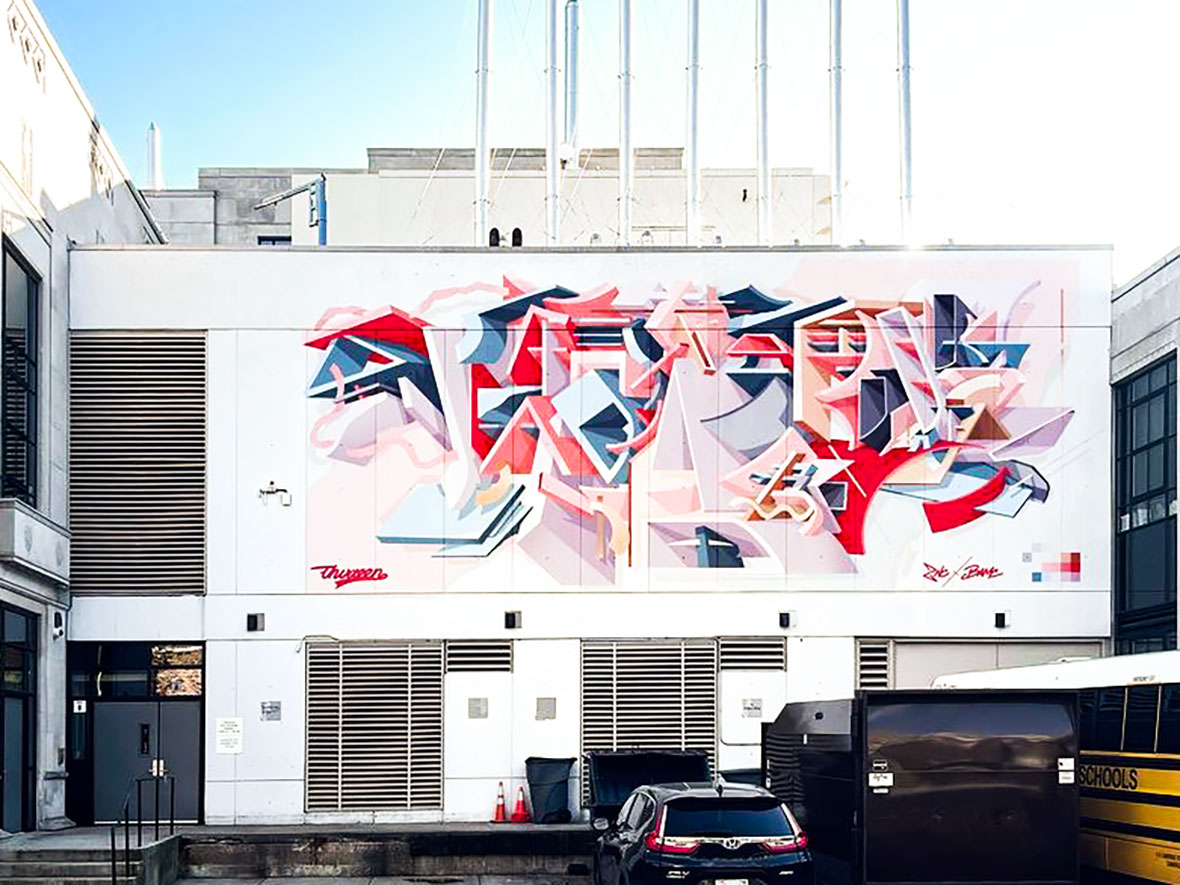
During the Black Lives Matter protests in 2020 after the death of George Floyd, Exas decided to start Yellow Peril. Alongside crew member Elvis, they had wanted to start a crew dedicated to supporting graffiti in Asian languages, and this seemed like a good moment. “Since I listen to rap music and consume other forms of Black culture, I wanted to do something to support them.” Yellow Peril was a xenophobic term used to refer to Asian immigrants that was coopted by activists during the 1960s civil rights movement and they were aligned with Black power movements like the Black Panthers.
2020 年,非裔美国公民乔治·弗洛伊德(George Floyd)离世,让抗议一触即发。也是在那个时候,灵丹与埃尔维斯(Elvis)决定创立“黄祸”。灵丹说,“我平时听很多说唱,我自己就是黑人文化的受众,所以想做一些能支持他们的事”。而“黄祸”这个名称,本身带有一种仇恨和敌意。但在近代,这个词指代 20 世纪 60 年代的民权运动中与黑豹党(Black panther)等黑人权力运动结盟的亚洲移民。
Given the different layers of cultural context, it proved difficult to communicate their meaning. “In China, if you write ‘yellow peril’ in Chinese and they search it, they get angry because they think you’re insulting them,” Exas admits. “It’s a derogatory term originally. I’ve gotten a lot of hate mail over it.” He also made T-shirts, but his European crewmates were uncomfortable wearing them because a white guy wearing a “yellow peril” shirt might seem racist. “So now I write YP, unless it’s in a more private place.”
After the wave of hate crimes against Asians in Western countries across the world, it took on an extra urgency. “I’m trying to say that if you’re Chinese or Asian, you don’t have to be afraid or ashamed, you can be proud,” he says, before ending with an apathetic note: “But graffiti can’t change shit.”
可往往这类术语容易引起他人的误会。灵丹承认:“在中国,如果你用中文写‘黄祸’这个词,人们会认为你在侮辱他们,我也因此遇到很多恶意。”灵丹还制作了印有团队名称的T恤,但他的欧洲团员们并不敢穿:“因为一个白人穿着写有‘黄祸’二字的T恤,可能会被当作是种族主义者。所以现在,我们都用 YP 简写代替了。”
当西方国家卷起亚裔仇恨的风波,汉字涂鸦对于他们来说成了当务之急。灵丹说:“我想告诉所有人,无论你来自亚洲任何地方,你都应该感到骄傲,而不是害怕或羞耻。但可悲的是,涂鸦往往无济于事,什么都改变不了。”
Like our stories? Follow us on Facebook and Instagram.
Instagrams:
@yellow_peril_crew
@ghettosino
@gudiii
@reset_swg
@dohak625
@pasleparadis
@chanthirteen
@candylien1203
@boms_boming_here
Contributor: Mike Steyels
Chinese Translation: Young Yang
Instagrams:
@yellow_peril_crew
@ghettosino
@gudiii
@reset_swg
@dohak625
@pasleparadis
@chanthirteen
@candylien1203
@boms_boming_here
供稿人: Mike Steyels
英译中: Young Yang

